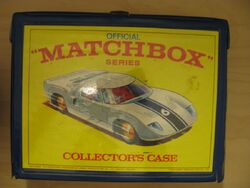Matchbox has released several carry cases, most often shaped as an attache case and featuring removable trays, each tray accepting twelve models. The twelve-model arrangement for the trays meant that most cases carried a multiple of that number: 12, 24, 48, 72, or 96 models, with 48 being the most common. Nonstandard cases, where the case took the shape of a steering wheel or other object, featured molded-in compartments and therefore didn't conform to this pattern. Later cases were licensed by Matchbox, and bore the Matchbox name, but were manufactured by an independent company.
At least one case unfolded, once the trays were removed, to become a small play mat with marked roads and buildings.
Evolution of the Trays[]

A Lamborghini Countach (1973) is seen in one of this 1976 tray's center compartments, emphasizing the height of the dividers. Josiah Carberry Collection.
The original cases featured cardboard dividers to separate stored models, but by the mid to late 1960s, plastic trays had become standard. Consistently, these trays accepted twelve vehicles in a three rows of four vehicles each, with the slots of the first and last row slightly longer than those of the middle row. Over time, however, the trays underwent ease-of-use changes. Though the outside walls of the trays were typically an open lattice, early trays used tall, solid dividers between their slots - cars stored in the center slots could be difficult to remove without inverting the tray. Later trays reduced the height of the internal dividers, which helped fingers get in to pull out taller cars and trucks, but were not useful for retrieving the lowest models (e.g. the Ferrari 308 GTB or the Lamborghini Countach LP500S). Eventually, Matchbox replaced part of each slot's bottom with tab that could be pushed in from below, lifting the imprisoned car enough that it could now be easily lifted out, but this design did not persist.

A tray with extra-long compartments (at corners).
The tray compartments also changed, with later trays omitting the divisions between two pairs of compartments to form two double-length compartments that would accept longer vehicles (e.g. trailers from the convoy series). Alternately, these extra-long compartments could be filled with two normal-sized vehicles or three particularly small ones, at the risk of paint chips as the case was carried.
Convoy Carry Case[]

Lesney also released a case for the Matchbox Convoy trucks, with a 1982 copyright date. This case features two stacking vacuformed trays, each with twelve slots arranged in a two by six arrangement. The slots are long enough to accept the then-available generation two tractor-trailers, though some later-issued trailers have to be uncoupled from their tractors if they are to fit.

Matchbox Convoy Carry Case
Nonstandard Cases[]
As early as the mid 1980s, Matchbox began to experiment with single-piece cases in which the shell of the case included slots for the cars to fit in. Incorporating the slot dividers into the case itself strengthened the case (the standard case was flimsy without its trays, and the trays themselves were prone to minor breakage) and allowed for some over-sized slots, but efficient use of this arrangement required deep, narrow slots in which models were parked head (or tail) in. Making the slots long and high enough to fit most models meant that the smallest models almost vanished into the case, and without a removable tray, the entire case had to be inverted to free trapped cars. Many of these cases also bore the shape of a steering wheel or other object, shapes which appealed to kids but failed to stack neatly, if at all; storing multiple cases became a challenge.
|
|---|







